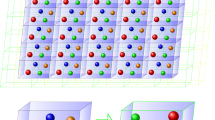Abstract
The optimum fluctuation method (OFM) has been applied to the tails of the density of states, arising near the edges of the spherically symmetric degenerate bands. In this case the optimum fluctuations (OF) have been shown to undergo a qualitative change, as compared to the case of nondegenerate bands, they lose the spherical symmetry and become elongated or flattened. This means that spontaneous breaking of symmetry takes place. In addition to the usual mechanism of tailing due to the potential of impurities, another mechanism connected with the field of random deformations, arising due to difference in the size of the guest and host atoms, has been also considered. The method used for treating this problem is intimately related to the techniques of the theory of self-trapping. The density of states in the tails, and in some cases the shape of OFs, have been found for all the cases under consideration.
Similar content being viewed by others
References
I. M. Lifshitz, S. A. Gredeskul, and L. A. Pastur,Introduction to the Theory of Disordered Systems (Nauka, Moscow, 1982) (English edition: J. Wiley & Son, New York, in press).
B. I. Halperin and M. Lax,Phys. Rev. 148:722 (1966).
J. Zittarz and J. S. Langer,Phys. Rev. 148:741 (1966).
I. M. Lifshitz,Zh. Exp. Teor. Fiz. 53:743 (1967) [Sov. Phys.-JETP 26:462 (1968)].
B. I. Shklovskii and A. L. Efros,Electronic Properties of Doped Semiconductors (Nauka, Moscow, 1981) (English edition: Springer-Verlag, Berlin, 1984).
V. L. Bonch-Bruevich, I. P. Zvyagin, R. Keiper, A. G. Mironov, R. Enderlein, and B. Esser,Electronentheorie of Disordered Semiconductors (Nauka, Moscow, 1981) (German edition: Elektronentheorie den ungeorneter Halbleiter, Deutscher Verlag der Wissenschaften, Berlin, 1984).
S. Lai and M. V. Klein,Phys. Rev. Lett. 44:1087 (1980).
E. Cohen and M. D. Sturge,Phys. Rev. B 25:3828 (1982).
S. Permogorov, A. Reznitskii, S. Verbin, G. O. Müller, P. Flögel, and N. Nikiforova,Phys. Stat. Sol. (b) 113:589, 1982.
R. J. Nelson, inExcitons, E. I. Rashba and M. D. Sturge, eds. (North-Holland, Amsterdam, 1982), p. 319.
S. D. Baranovskii and A. L. Efros,Fiz. Tekh. Polupr. 12:2233 (1978) [Sov. Phys. Semicond. 12:1328 (1978)].
F. V. Kusmartsev and E. I. Rashba,Pis'ma Zh. Eksp. Teor. Fiz. 37:106 (1982) [Sov. Phys.-JETP Lett. 37:130 (1983)].
F. V. Kusmartsev and E. I. Rashba, inGroup Theoretical Methods in Physics, vol. II (Proc. of Int. Seminar, Zvenigorod, 1982), (Nauka, Moscow, 1983), p. 453 and (Gordon and Breach, London, 1984), p. 469.
F. V. Kusmartsev and E. I. Rashba, inCooperative Phenomena (Proc. of Int. Symp. “Synergetics and Cooperative Phenomena in Solids and Macromolecules,” Tallinn 1982) (Valgus, Tallinn, 1983), p. 193.
N. N. Ablyazov, M. E. Raikh, and A. L. Efros,Pis'ma Zh. Eksp. Teor. Fiz. 38:103 (1983) [Sov. Phys.-JETP Lett. 38:120 (1983)].
S. A. Permogorov, A. N. Reznitskii, S. Yu. Verbin, and V. G. Lysenko,Pis'ma Zh. Eksp. Teor. Fiz. 37:390 (1983) [Sov. Phys.-JETP Lett. 37:462 (1983)].
J. M. Luttinger,Phys. Rev. 102:1030 (1956).
G. L. Bir and G. E. Pikus,Symmetry and Strain-Induced Effects in Semiconductors (Nauka, Moscow, 1972) [English edition: Halsted Press, New York, 1974].
R. A. Faulkner,Phys. Rev. 175:991 (1968).
E. I. Rashba, inExcitons, E. I. Rashba and M. D. Sturge, eds. (North-Holland, Amsterdam, 1982), p. 543.
F. V. Kusmartsev and E. I. Rashba,Zh. Eksp. Teor. Fiz. 86:1142 (1984).
S. I. Pekar,Research in the Electron Theory of Crystals, (Gostekhizdat, Moscow, 1951) [German edition:Untersuchungen über die Elektronentheorie des Kristallen (Akademie Verlag, Berlin, 1954)].
J. W. Allen,J. Phys. C-Solid State Phys. 1:1136 (1968);4:1936 (1971).
F. V. Kusmartsev and E. I. Rashba,Fiz. Tekh. Polupr. 18:691 (1984).
Author information
Authors and Affiliations
Rights and permissions
About this article
Cite this article
Kusmartsev, F.V., Rashba, E.I. Spontaneous symmetry breaking of optimum fluctuations in semiconductors. J Stat Phys 38, 313–327 (1985). https://doi.org/10.1007/BF01017864
Received:
Issue Date:
DOI: https://doi.org/10.1007/BF01017864




